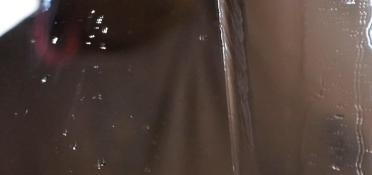In “Only,” Maxine Flasher-Düzgüneş pairs Rebecca Foust’s poem with a dancer’s movements to illuminate the affinities shared by the video poem and the dance film, genres that extend the reaches of a performance space. In the opening frame, a finger traces the title’s four letters into the slope of a sand dune. “In a room with green walls, my son was born,” says a voice that is and is not coming from a figure weaving through the beachgrass. The dancer on screen moves as if to excise something. “When finally he spoke,” the poem says, “he spoke the wide, whorled leaves of corn, he spoke the crickets and clusters beneath the sheaves.” By placing the text outside of the book and the dancer far from her stage, “Only” offers time-based strategies for emphasis and arrangement, new ways for the audience to encounter a sudden wash that sounds like grief.
In “Cameras are clocks for seeing” Chelsea Werner-Jatzke uses a stack of 3x5 photographs to time travel. Studying six cityscapes that were stacked for years in her husband’s dresser drawer, Werner-Jatzke looks through the eye of a beloved before she ever met them. In the caption below the photograph, Roland Barthes wonders, “Is landscape itself only a kind of loan made by the owner of the terrain?” Each photograph is a still, but not stuck, Werner-Jatzke reminds us as traffic roars softly in the video and the bleat of a forklift announces it is also moving backwards. “Now I’ve had you half as long,” Werner-Jatzke writes, “as here has had me.” “Cameras are clocks or seeing” invites us to consider not only the changing skyline but the divided versions of self, beloved, and place that double lenses reveal.
“In your dialect, where does the sun go down?” Asks Irene Hsu’s “Excerpts from EARTH INTELLIGENCE,” a video wearing the form of a questionnaire like a misspelled name tag. “The sea heaved them up and hurled them back,” the voice replies, “We worked so hard for what we hardly use now.” A clip from Hou Hsiao Hsien's Boys From Fengkuei, then a shot of a long dock stretching out to sea. A radio satellite revolving, then an aerial shot of Taiping. “Excerpts from EARTH INTELLIGENCE” binds image with text to tell the story of diaspora as a tale of forced labor turned mechanized surveillance. Using what they call “a poetics of ‘remote-sensing,’” Hsu invites the viewer to consider the ongoing relationship of mines to contested islands, living sea turtles to dead flags: “A series of strong gates receded to a series of decomposed pedestals beckoning, a series of ghosts felled for a series of jumping jacks, locked and loaded by a series of men shipped out to lay runways through a series of trees cleared for the hunger of a series of orbits from outer space.”
A Special Insert from Good Symptom, a digital film anthology from 3rd Thing Press
Part biography, part meditation on a life lived beyond available language, Naima Lowe’s “According to Sun Ra, None of Us are Real,” considers the jazz musician from Birmingham who once opened for Sonic Youth and who lived, slept, and died, above all, “as a smart, weird, piano-playing faggot.” The piece layers documentary text from the courtroom where Sun Ra was tried for refusing to go to war with facts about an ocean-dwelling species that survives “by drinking the starlight.” Throughout the piece, a curtain, a mirror, or a window divides the viewfinder from a figure reflected in glass that drips with water. “Black people need scuba gear to breathe on land,” explains the speaker, weaving images that could describe the middle passage as easily as they might depict a life of seeking transcendence. Something behind the story shudders as the voice aligns with text projected on screen, then escapes it. The camera refocuses itself as Lowe’s video restores the biopic to its plural form.
About Good Symptom: A serial anthology of genre-fluid short films and critical essays, The 3rd Thing’s first time-based publication troubles the boundaries between cinematic and literary forms, showcasing innovative work that pushes the language of poetry, essay, memoir and fiction off the page and onto the screen. Every month, subscribers to Good Symptom receive 1-3 short films and accompanying critical essays by project curators.



